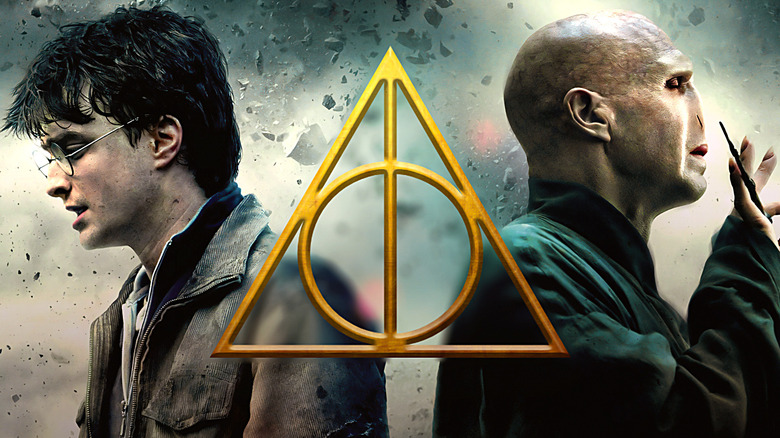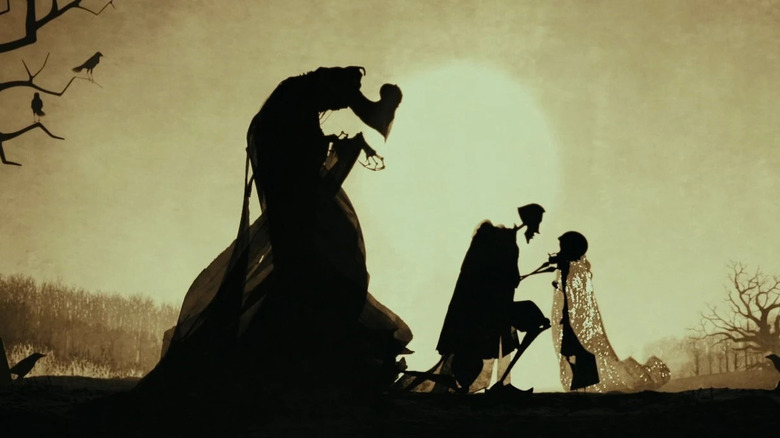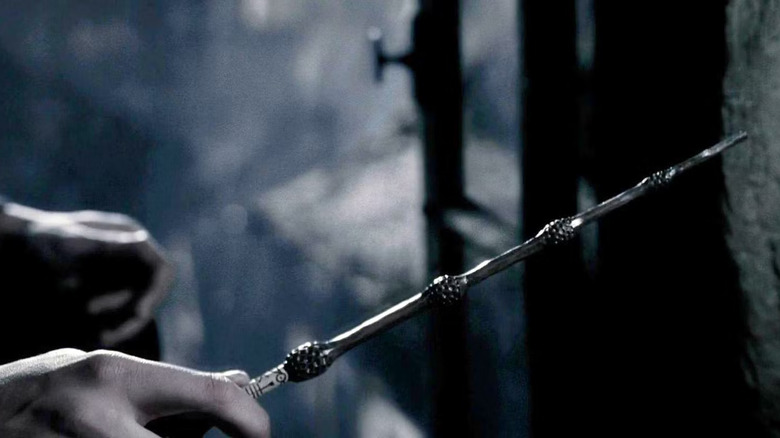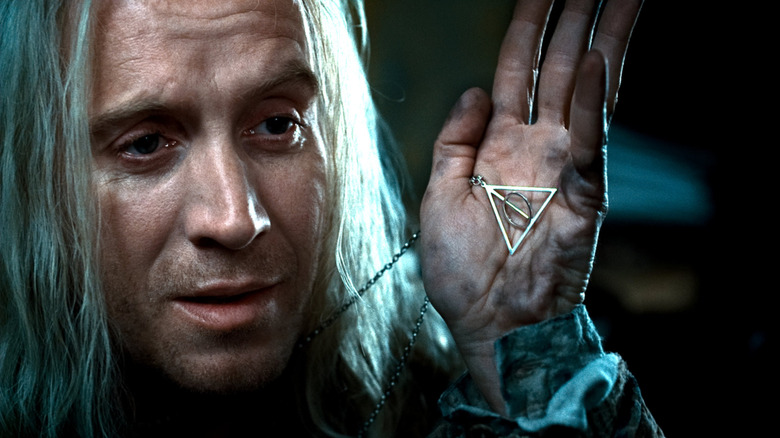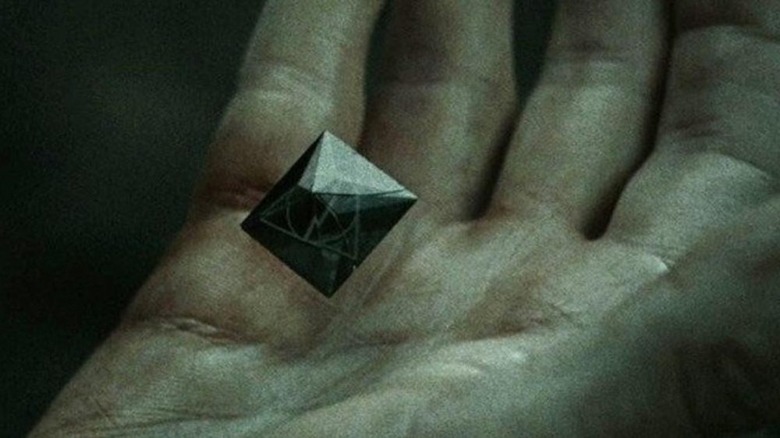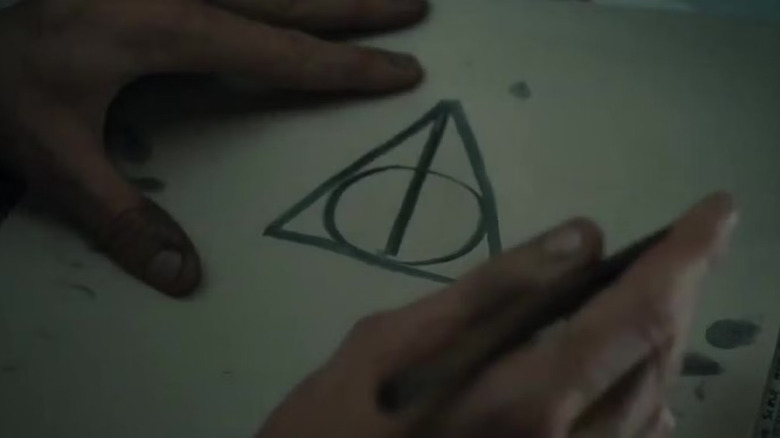Harry Potter's Deathly Hallows Symbol Explained - Is It Good Or Bad?
This article contains a mention of suicide.
Fans of the "Harry Potter" franchise know that the magical universe is packed full of wild magical objects — and they tend to serve huge narrative purposes. In the first installment, "Harry Potter and the Sorcerer's Stone," that titular stone is hidden in the bowels of Hogwarts School of Witchcraft and Wizardry thanks to the fact that it promises eternal life to whomever has it, making it very tempting for certain evil wizard spirits who might, say, want to regain their corporeal forms. Another titular object, the Goblet of Fire, accepts entries from Hogwarts students (and students from other wizarding schools) and chooses champions for the Triwizard Tournament, but it causes a stir when it chooses a too-young Harry Potter (Daniel Radcliffe) as a fourth champion. With all that said, what's the deal with the Deathly Hallows?
The three magical items that double as the title for the last book and two-part film in the franchise happen to be three of the most interesting enchanted objects in the entire wizarding world — and when Harry and his best friends Ron Weasley (Rupert Grint) and Hermione Granger (Emma Watson) learn about the legendary trio, they realize that one of their number has actually belonged to Harry for years. Here's everything you need to know about the Deathly Hallows, whether they're "good" or "bad," and why they're so important in the "Harry Potter" universe.
What are the three Deathly Hallows?
In both the book and movie, Hermione reads a story from a children's book, "The Tales of Beedle the Bard," aloud that explains the strange origin of the three items known as the Deathly Hallows. Here's the gist: three brothers end up facing Death, who offers them anything they wish after they magically build a bridge and "outsmart" him (a non-magical person would have died trying to cross the crevasse they bridged). The eldest brother, who's the most arrogant, asks for a wand more powerful than any other, while the middle brother requests a stone that can revive the dead. The youngest brother asks for something that can "hide" him from death. Ultimately, this backfires on the first two brothers: the oldest one boasts that nobody can defeat him, so someone murders him without magic and steals the wand, and the middle brother uses the stone to revive the deceased woman he loved only to die by suicide so he can be with her forever (the stone doesn't actually bring anyone back, but merely provides a ghostly echo of the person). Only the youngest lives a long and natural life by using the cloak of invisibility; as he prepares to "[greet] Death as an old friend," he passes the cloak to his son.
So there you have it: the items are the "undefeatable" Elder Wand, the Resurrection Stone, and the Cloak of Invisibility. Even the most casual Potterheads know that, in the very first book and movie, Harry receives the Cloak of Invisibility as an anonymous Christmas gift with a note that reveals it belonged to his own father. (This is a slightly less important detail, but Harry eventually learns that his father James is a descendant of the real youngest brother, Ignotus Peverell, upon whom the tale is based.)
What is the purpose of the Deathly Hallows?
Individually, it's understandable that wizards would seek the three Deathly Hallows. According to Xenophilius Lovegood — father of Evanna Lynch's Luna Lovegood who's played by Rhys Ifans in the films — there are many people in the wizarding world who are on the "quest" to find the Hallows for one specific purpose. When Hermione points out that the whole thing originates from a children's book, Xenophilius brushes that off somewhat. "That is a children's tale, told to amuse rather than to instruct," he tells her. "Those of us who understand these matters, however, recognize that the ancient story refers to three objects, or Hallows, which, if united, will make the possessor master of Death." So there you have it: Xenophilius and his ilk want to collect the items because they believe that they could best Death, like the brothers attempted to, if they possess all three.
Whether or not this is true never gets confirmed, but Harry does use all three items to full effect before "Deathly Hallows" ends. The cloak is his, and he uses it to evade Voldemort (Ralph Fiennes) constantly. He uses the Stone to recall his parents and lost loved ones as he approaches Voldemort, ready to die in order to destroy the Horcrux within him. Finally, he proves that, thanks to a complicated series of duels that happen throughout "Deathly Hallows," he is the master of the Elder Wand, and uses that fact to defeat Voldemort once and for all (in the book, anyway).
Why does Lovegood wear the Deathly Hallows symbol?
In the book version of "Harry Potter and the Deathly Hallows," Xenophilius Lovegood causes a minor stir at a Weasley family wedding while wearing a necklace that bears the symbol of the Deathly Hallows, as other guests believe it's a symbol of the wizarding world's other super-evil wizard, Grindelwald. As Xenophilius explains to the trio later in the story when they visit his home, it's not a symbol of Grindelwald, but merely one that the dark wizard adopted. It's actually a symbol of the Hallows; as the editor of the Quibbler explains to Harry, Ron, and Hermione, the line represents the Elder Wand, the circle represents the Resurrection Stone, and the triangle represents the Cloak of Invisibility. It's not a good or bad symbol, per se, although some do associate with Grindelwald (unfortunately).
As I already mentioned, Xenophilius — who, like Luna, has some sort of oddball beliefs — believes there's a "quest" to find all three Hallows, so he's sort of obsessed with them and insists, despite Hermione's interruptions and arguments, that all three items are real. (A particularly ironic moment is when Xenophilius insists that only a "true" Cloak of Invisibility would never lose its efficacy or change in any way, while Harry, Ron, and Hermione mull over the fact that they have a cloak that fits that exact description on their person at that exact second.) Anyway, the point is that he just has a weird fixation on uniting the items and being the master of Death. Spoiler alert: he does not accomplish this.
The Deathly Hallows symbol has a connection to Harry Potter author J. K. Rowling
According to series author Joanne Kathleen Rowling, she was inspired to create the specific symbol for the Deathly Hallows thanks to one specific film: Sean Connery and Michael Caine's 1975 drama "The Man Who Would Be King." The movie features a Masonic symbol that sparked something for Rowling, who revealed in a documentary called "Harry Potter and the History of Magic" — which released in 2017 to commemorate the 20th anniversary of the first book's release (via the BBC) — that she thinks the symbol crept into her mind.
"The Masonic symbol is very important in that movie," Rowling said before clarifying why she thinks the two are related. "The reason I can be incredibly precise about when I drew [a picture of a Harry Potter character], is that at some point when I was drawing the picture and watching the movie, my mother died." As a result, Rowling is convinced that she internalized the symbol. "I looked at the sign of the Deathly Hallows and realised how similar they are," she said, recalling a time that she rewatched "The Man Who Would Be King" and felt "cold all over."
"The 'Potter' series is hugely about loss," Rowling said. "If my mother hadn't died, I think the stories would be utterly different and not what they are."
The Deathly Hallows symbol is a popular tattoo, but some Harry Potter fans are covering it up
The truth is that, in recent years, Joanne Kathleen Rowling's views on transgender women — which can only be described as "bad" — have alienated a whole lot of "Harry Potter" fans for quite understandable reasons. What does that have to do with the Deathly Hallows and the symbol? The symbol happens to be a very popular tattoo design for "Potter" fans, and people have gotten it covered up or removed in decently large numbers ever since Rowling revealed that she doesn't think transgender women are women.
Back in 2020, once Rowling became very vocal about that belief, Vice interviewed a handful of fans about their feelings on their Deathly Hallows symbol tattoos, and the end result was honestly really sad. A fan named Jordan, who, at the time, had a stick-and-poke tattoo of the Hallows on his leg, told the outlet he felt sort of gross supporting "Harry Potter" as an ally to the transgender community and had to re-evaluate how he felt about the series as a whole. "It no longer represents what it did," Jordan said. "It just felt like, okay, well, this thing that meant something to me, I have to reevaluate my relationship to it. The tattoo just started feeling like, if that was visible around my friends who are trans, I wouldn't want them to feel like I support the things that [Rowling] says."
Sure, this is just one example, but there are plenty of anecdotal stories about "Harry Potter" fans removing or covering their series-related tattoos over Rowling — and as a person who has a "Potter" tattoo and vehemently disagrees with Rowling's views, I understand the conflicted feeling. (I remain grateful that the three stars on my wrist were designed by illustrator Mary Grandpre, who has not shared any gross views regarding the transgender community.) In any case, Rowling's legacy has changed (and devolved) quite a lot in the past few years ... so, in a sense, the Deathly Hallows symbol is "bad" to some people.
If you or someone you know is struggling or in crisis, help is available. Call or text 988 or chat 988lifeline.org
